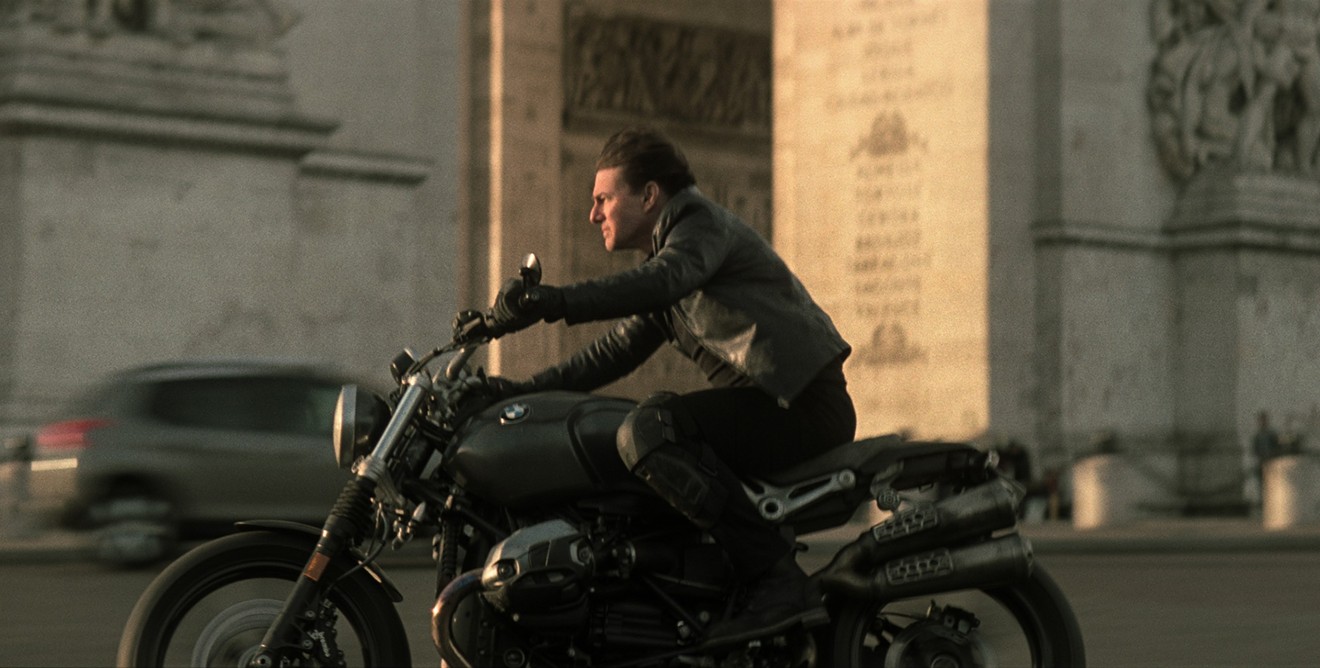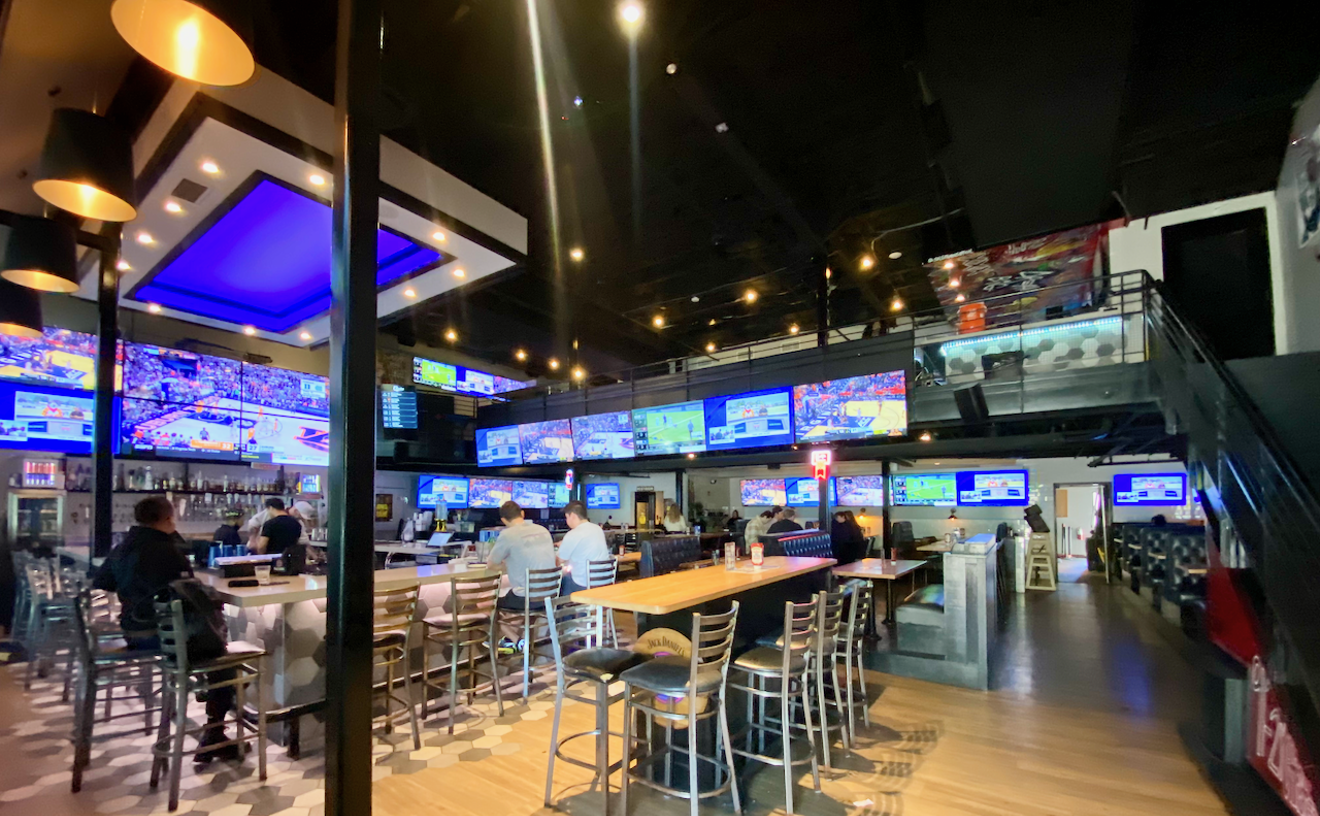The new Mission: Impossible opens with two scenes that, put together, constitute a clinic in how to handle exposition in a dumb, fun action spectacle. The first is a flashback-cum-dream vision in which we see the wedding of super-agent Ethan Hunt (Tom Cruise) to his long-suffering ex-wife Julia (Michelle Monaghan). A priest (who also happens to be Solomon Lane, the villain from the last movie — don’t ask too many questions, it’s a dream) delivers the wedding vows, which gradually segue into a gruesome litany of the troubles Ethan has caused Julia over the course of this series.
Just then, an ominous, explosive flash of light wakes up our hero. Now, we see that he’s all alone, in a dark, dank room somewhere in Belfast. A message arrives. It contains the details of his next mission, which involves a maze-like network of international arms dealers and nuclear scientists and nutty Year Zero anarchists, each betraying and counter-betraying the other. It’s such a dense, extravagant cascade of gobbledygook that I actually giggled in the theater as I tossed aside my notepad and pen.
A cinematic centrifuge of acrobatic stunt work, breakneck chases and immersive action, Mission: Impossible - Fallout is a perfectly calibrated piece of filmmaking that plays the viewer like a drum right from the start. Here’s a goofy dream vision to catch you up on the important emotional stakes. Got that? Good. Now, here’s some impenetrable blather to let you know that, yeah, it’s OK just to sit back and enjoy the ride. It’s not unlike what Whit Stillman achieves with the opening credits of his Jane Austen adaptation Love and Friendship, in which a hilarious rapid-fire procession of character descriptions and connections conveys the surreal intricacy of class and family loyalties in Georgian England while also relieving us of having to fuss over the cumbersome details.
After that opening blast of sweet confusion, what we actually get is little more than a series of excuses to get from Shootout A to Fight B to Chase C. Some plutonium is gone missing, a terror network with a mystery leader has it, there are bombs and secret agent Hunt and CIA assassin August Walker (Henry Cavill) have to pretend to work with one set of bad guys to stop the other set of bad guys. That results in increasingly delirious sequences in which the duo snipe at each other while ganging up on nemeses. Meanwhile, Rebecca Ferguson, reprising her scene-stealing role from the last film as British agent Ilsa Faust, appears regularly to save our heroes’ asses.
Along the way, there’s some rather predictable sexual tension between Ferguson and Cruise’s characters — and, to their credit, both actors sell it well, despite the rather chasmic age difference. But I’d argue that there’s a more compelling tension between Cavill and Cruise: They spend so much of the movie bickering and undercutting one another that their characters’ trajectory feels almost like it should be romantic. (Spoiler alert: It’s not.) And you cannot tell me that the filmmakers aren’t a little aware of this. The physical combat — in particular a spectacular three-way fight-fest in a nightclub men’s room that at one point has the participants going at it in a bathroom stall, where they are then briefly hounded by a group of eager, turned-on men who want to join in on whatever shenanigans are happening in there — boast a vigorous, athletic grace. Everybody always seems so damned enthused to mix it up in this movie. If dancing is merely the vertical expression of a horizontal desire, then the fighting in Mission: Impossible - Fallout could be the vertical, horizontal, diagonal, spinning, up-is-down, gravity-defying expression of, well, vertical, horizontal, diagonal, spinning, up-is-down, gravity-defying desires.
Beyond the playful double entendres and compromising positions, however, Mission: Impossible – Fallout represents a breakthrough for director Christopher McQuarrie, who also helmed the previous entry in the series, Rogue Nation. It’s the first time the franchise has allowed one of its auteurs a second shot behind the camera. Originally a screenwriter known for his sparkling dialogue, deft humor and twisty plotting (he won an Oscar for The Usual Suspects), McQuarrie brought to Rogue Nation hefty doses of understated wit and lightning-fast sweep. But he’s become an even better director in the meantime, building on the earlier film’s accomplishments. He puts together the action in Fallout with a storyteller’s eye, making sure every face-off has some kind of shape, mini-narratives within narratives. The fights develop in unusual ways; the chases take unexpected turns; the camera keys in on an offhand detail or a subtle spatial relationship that later turns out to mean the world. The dispersal of information, be it through a shot, a movement or a line of dialogue, is one of the less heralded but more crucial tasks of mainstream filmmaking, and McQuarrie handles it exceptionally well. The story itself may be dumb, but the movie knows exactly what it’s doing when it comes to action and spectacle.
The Mission: Impossible films were once a bit conflicted on this matter. The first one went into production as a series of elaborate set pieces with little proper narrative logic to connect them. That reportedly caused some strife during production, and the finished film — as exciting, and brilliantly directed as it was — dissatisfied many fans of the original TV show, who had expected clever spycraft and selfless teamwork, not Tom Cruise killing helicopters. Since then, the best entries have worked the spectacle and the stunts. So much so that Cruise’s death-defying antics — hanging onto real jet airplanes, scaling real skyscrapers — have become a regular promotion tactic for these pictures. Cruise’s insistence on doing his own stunts, and publicizing them, once seemed like a shallow movie star indulgence, but it’s now a welcome throwback in an age of animated heroes and bloodless, computerized menace.
The actor has more of those publicity friendly antics in this one, naturally. The biggest involves climbing a rope attached to a helicopter flying over the mountains of Kashmir. But perhaps the most impressive stunt here is how he and director McQuarrie, even after all the knocks that the star’s image and career have taken over the past decade or so, have fashioned something so resoundingly exciting, so charmingly confident in its use of the star’s irrepressible charisma. I’ve enjoyed much of Cruise’s recent work, but here he does something more: He makes you believe in movie stars again.
[
{
"name": "Air - MediumRectangle - Inline Content - Mobile Display Size",
"component": "18855504",
"insertPoint": "2",
"requiredCountToDisplay": "2"
},{
"name": "Editor Picks",
"component": "17105533",
"insertPoint": "4",
"requiredCountToDisplay": "1"
},{
"name": "Inline Links",
"component": "18349797",
"insertPoint": "8th",
"startingPoint": 8,
"requiredCountToDisplay": "7",
"maxInsertions": 25
},{
"name": "Air - MediumRectangle - Combo - Inline Content",
"component": "17105532",
"insertPoint": "8th",
"startingPoint": 8,
"requiredCountToDisplay": "7",
"maxInsertions": 25
},{
"name": "Inline Links",
"component": "18349797",
"insertPoint": "8th",
"startingPoint": 12,
"requiredCountToDisplay": "11",
"maxInsertions": 25
},{
"name": "Air - Leaderboard Tower - Combo - Inline Content",
"component": "17105535",
"insertPoint": "8th",
"startingPoint": 12,
"requiredCountToDisplay": "11",
"maxInsertions": 25
}
]











